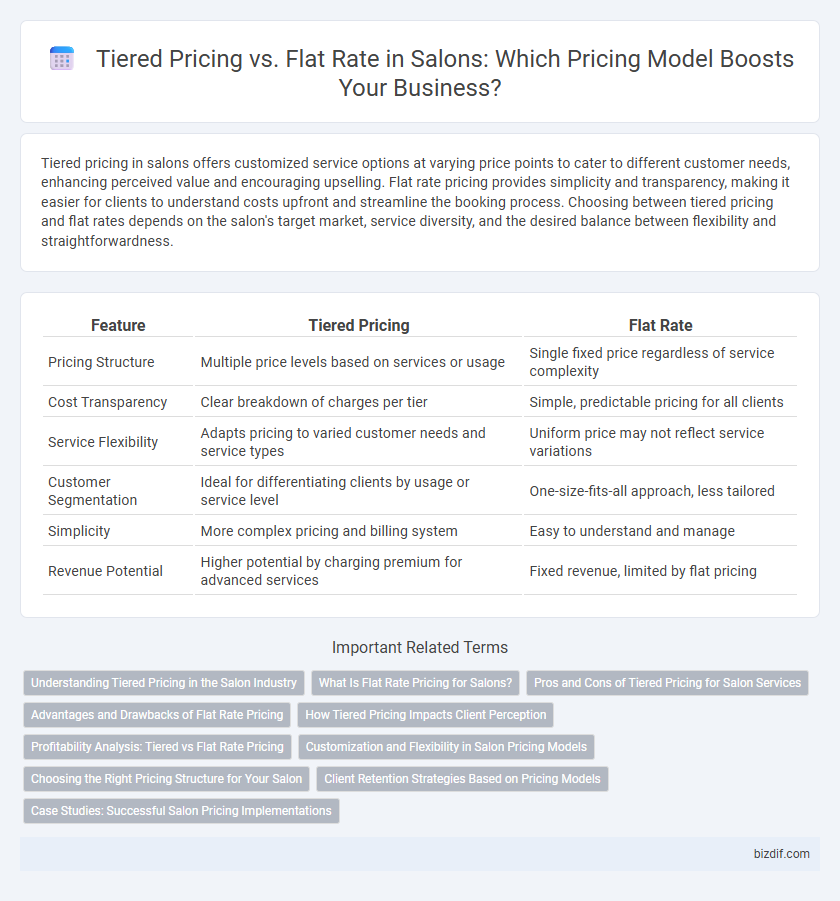Tiered pricing in salons offers customized service options at varying price points to cater to different customer needs, enhancing perceived value and encouraging upselling. Flat rate pricing provides simplicity and transparency, making it easier for clients to understand costs upfront and streamline the booking process. Choosing between tiered pricing and flat rates depends on the salon's target market, service diversity, and the desired balance between flexibility and straightforwardness.
Table of Comparison
| Feature | Tiered Pricing | Flat Rate |
|---|---|---|
| Pricing Structure | Multiple price levels based on services or usage | Single fixed price regardless of service complexity |
| Cost Transparency | Clear breakdown of charges per tier | Simple, predictable pricing for all clients |
| Service Flexibility | Adapts pricing to varied customer needs and service types | Uniform price may not reflect service variations |
| Customer Segmentation | Ideal for differentiating clients by usage or service level | One-size-fits-all approach, less tailored |
| Simplicity | More complex pricing and billing system | Easy to understand and manage |
| Revenue Potential | Higher potential by charging premium for advanced services | Fixed revenue, limited by flat pricing |
Understanding Tiered Pricing in the Salon Industry
Tiered pricing in the salon industry allows businesses to offer services at multiple price points based on stylist experience, service complexity, or duration, catering to a diverse client base. This pricing strategy enhances customer satisfaction by providing options that align with varying budgets and preferences, while optimizing revenue through upselling premium services. Understanding tiered pricing helps salons effectively manage resources, attract a wider clientele, and increase profitability compared to flat rate pricing models.
What Is Flat Rate Pricing for Salons?
Flat rate pricing for salons involves charging a single, fixed price for specific services regardless of time or complexity. This approach simplifies billing by offering clients predictable costs for treatments such as haircuts, coloring, or styling. Salons benefit from streamlined operations and enhanced client satisfaction due to transparent and consistent pricing.
Pros and Cons of Tiered Pricing for Salon Services
Tiered pricing in salon services offers clients flexible options based on service levels, encouraging increased spending and catering to diverse budgets. This model can boost customer satisfaction through personalized pricing but may complicate staff scheduling and inventory management. However, tiered pricing requires clear communication to avoid customer confusion and perceived unfairness.
Advantages and Drawbacks of Flat Rate Pricing
Flat rate pricing in salons offers simplicity and transparency, allowing clients to understand costs upfront without surprise fees, which can improve customer trust and streamline billing processes. This model may limit revenue potential during high-demand periods or with clients requiring extensive services, as the fixed price does not account for time or resource variations. Salons risk undercharging for complex treatments or overcharging for quick services, potentially affecting client satisfaction and profitability.
How Tiered Pricing Impacts Client Perception
Tiered pricing in salons creates a perception of personalized service by offering multiple options that cater to different budgets and preferences. Clients often view tiered pricing as transparent and flexible, making them feel empowered to choose services that best meet their needs without surprise fees. This strategy can enhance customer trust and satisfaction compared to flat rate pricing, which may be perceived as rigid or less accommodating.
Profitability Analysis: Tiered vs Flat Rate Pricing
Tiered pricing in salons enables targeted revenue growth by charging clients based on service complexity or time, increasing profit margins on premium offerings. Flat rate pricing simplifies billing but may limit profitability by averaging costs and reducing flexibility to capture higher value services. Analyzing client distribution and service demand is key to determining whether tiered pricing yields higher overall profitability compared to a flat rate model.
Customization and Flexibility in Salon Pricing Models
Tiered pricing in salons allows for customization by offering multiple service levels and price points tailored to varying client needs and preferences, enhancing flexibility compared to a flat rate. This model enables salons to adjust prices based on factors such as stylist experience, service complexity, and appointment duration, improving customer satisfaction and revenue potential. Flat rate pricing, while straightforward, limits adaptability and may not accurately reflect the diverse value of personalized services in a salon setting.
Choosing the Right Pricing Structure for Your Salon
Selecting the right pricing structure for your salon significantly impacts customer satisfaction and revenue management. Tiered pricing offers flexibility by categorizing services into multiple price levels based on complexity or time, attracting diverse client segments and optimizing profit margins. Flat rate pricing provides simplicity and predictability, making it easy to communicate costs and streamline operations, especially ideal for salons targeting a uniform service experience.
Client Retention Strategies Based on Pricing Models
Tiered pricing in salons enhances client retention by offering customizable service packages that cater to diverse client budgets and preferences, encouraging repeat visits and upselling opportunities. Flat rate pricing simplifies billing and builds trust through transparent costs, appealing to clients who value consistency and predictability in their salon experience. Strategic implementation of tiered or flat rate models, aligned with client demographics and service complexity, directly influences loyalty and long-term retention rates.
Case Studies: Successful Salon Pricing Implementations
Case studies reveal salons utilizing tiered pricing often experience increased client retention by offering customized service levels that match diverse customer budgets and preferences. Flat rate pricing models simplify transactions and enhance transparency, leading to faster service turnover and higher overall revenue in salons with consistent, uniform service offerings. Successful implementations highlight the importance of aligning pricing strategy with salon target demographics and service complexity to drive profitability.
Tiered Pricing vs Flat Rate Infographic

 bizdif.com
bizdif.com